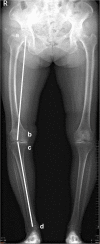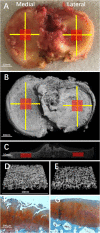Association between knee alignment, osteoarthritis disease severity, and subchondral trabecular bone microarchitecture in patients with knee osteoarthritis: a cross-sectional study
- PMID: 32887657
- PMCID: PMC7487480
- DOI: 10.1186/s13075-020-02274-0
Association between knee alignment, osteoarthritis disease severity, and subchondral trabecular bone microarchitecture in patients with knee osteoarthritis: a cross-sectional study
Abstract
Background: Knee osteoarthritis (OA) is a common disabling disease involving the entire joint tissue, and its onset and progression are affected by many factors. However, the current number of studies investigating the relationship between subchondral trabecular bone (STB), knee alignment, and OA severity is limited. We aimed to investigate the variation in tibial plateau STB microarchitecture in end-stage knee OA patients and their association with knee alignment (hip-knee-ankle, HKA, angle) and OA severity.
Methods: Seventy-one knee OA patients scheduled for total knee arthroplasty (TKA) underwent preoperative radiography to measure the HKA angle and Kellgren-Lawrence grade. Tibial plateaus collected from TKA were scanned using micro-computed tomography to analyze the STB microarchitecture. Histological sections were used to assess cartilage degeneration (OARSI score). Correlations between the HKA angle, OA severity (OARSI score, Kellgren-Lawrence grade), and STB microarchitecture were evaluated. Differences in STB microstructural parameters between varus and valgus alignment groups based on the HKA angle were examined.
Results: The HKA angle was significantly correlated with all STB microarchitecture parameters (p < 0.01). The HKA angle was more correlated with the medial-to-lateral ratios of the microarchitecture parameters than with the medial or lateral tibia plateaus. The HKA angle and all STB microarchitecture parameters are significantly correlated with both the OARSI score and Kellgren-Lawrence grade (p < 0.01).
Conclusions: The STB microarchitecture is associated with the HKA angle and OA severity. With the increase of the knee alignment deviation and OA severity, the STB of the affected side tibial plateau increased in bone volume, trabecular number, and trabecular thickness and decreased in trabecular separation.
Keywords: Hip-knee-ankle angle; Knee osteoarthritis; Micro-CT; Microarchitecture; Subchondral trabecular bone.
Conflict of interest statement
The authors declare that they have no competing interests.
Figures




Similar articles
-
Abnormal subchondral trabecular bone remodeling in knee osteoarthritis under the influence of knee alignment.Osteoarthritis Cartilage. 2022 Jan;30(1):100-109. doi: 10.1016/j.joca.2021.10.005. Epub 2021 Oct 23. Osteoarthritis Cartilage. 2022. PMID: 34699993
-
Relationships between in vivo dynamic knee joint loading, static alignment and tibial subchondral bone microarchitecture in end-stage knee osteoarthritis.Osteoarthritis Cartilage. 2018 Apr;26(4):547-556. doi: 10.1016/j.joca.2018.01.014. Epub 2018 Jan 31. Osteoarthritis Cartilage. 2018. PMID: 29382604
-
Tibial cartilage, subchondral bone plate and trabecular bone microarchitecture in varus- and valgus-osteoarthritis versus controls.J Orthop Res. 2021 Sep;39(9):1988-1999. doi: 10.1002/jor.24914. Epub 2020 Nov 25. J Orthop Res. 2021. PMID: 33241575
-
Highly variable coronal tibial and femoral alignment in osteoarthritic knees: a systematic review.Knee Surg Sports Traumatol Arthrosc. 2019 May;27(5):1368-1377. doi: 10.1007/s00167-019-05506-2. Epub 2019 Apr 15. Knee Surg Sports Traumatol Arthrosc. 2019. PMID: 30989273
-
Hemodynamic stress shapes subchondral bone in osteoarthritis: An emerging hypothesis.J Orthop Translat. 2021 Dec 30;32:85-90. doi: 10.1016/j.jot.2021.11.007. eCollection 2022 Jan. J Orthop Translat. 2021. PMID: 35070712 Free PMC article. Review.
Cited by
-
Stress on the posteromedial region of the proximal tibia increased over time after anterior cruciate ligament injury.Knee Surg Sports Traumatol Arthrosc. 2022 May;30(5):1744-1751. doi: 10.1007/s00167-021-06731-4. Epub 2021 Sep 10. Knee Surg Sports Traumatol Arthrosc. 2022. PMID: 34505928
-
The effect of kinesio taping on joint range of motion and balance in total knee replacement patients.J Exerc Rehabil. 2024 Aug 31;20(4):131-136. doi: 10.12965/jer.2442254.127. eCollection 2024 Aug. J Exerc Rehabil. 2024. PMID: 39228966 Free PMC article.
-
Biomechanical and clinical relationships between lower back pain and knee osteoarthritis: a systematic review.Syst Rev. 2023 Mar 2;12(1):28. doi: 10.1186/s13643-022-02164-3. Syst Rev. 2023. PMID: 36864486 Free PMC article.
-
Outcomes of cruciate-retaining total knee arthroplasty for osteoarthritis with severe varus deformity.Eur J Orthop Surg Traumatol. 2023 Aug;33(6):2465-2472. doi: 10.1007/s00590-022-03463-0. Epub 2022 Dec 19. Eur J Orthop Surg Traumatol. 2023. PMID: 36536108
-
Tibial tubercle-Roman arch (TT-RA) distance is superior to tibial tubercle-trochlear groove (TT-TG) distance when evaluating coronal malalignment in patients with knee osteoarthritis.Eur Radiol. 2022 Dec;32(12):8404-8413. doi: 10.1007/s00330-022-08924-y. Epub 2022 Jun 22. Eur Radiol. 2022. PMID: 35729426
References
-
- Glyn-Jones S, Palmer AJ, Agricola R, Price AJ, Vincent TL, Weinans H, et al. Osteoarthritis. Lancet. 2015;386(9991):376–387. - PubMed
-
- Cross M, Smith E, Hoy D, Nolte S, Ackerman I, Fransen M, et al. The global burden of hip and knee osteoarthritis: estimates from the global burden of disease 2010 study. Ann Rheum Dis. 2014;73(7):1323–1330. - PubMed
-
- Lories RJ, Luyten FP. The bone-cartilage unit in osteoarthritis. Nat Rev Rheumatol. 2011;7(1):43–49. - PubMed
Publication types
MeSH terms
LinkOut - more resources
Full Text Sources

